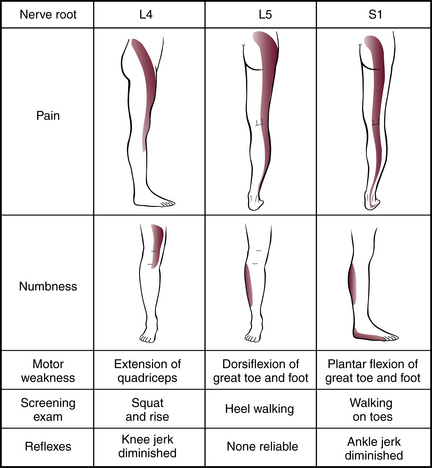CHAPTER 21 Low back pain (acute)
 Potentially serious conditions (e.g., spinal fracture, tumor or infection, or cauda equina syndrome)
Potentially serious conditions (e.g., spinal fracture, tumor or infection, or cauda equina syndrome)
 Sciatica, or leg pain and numbness of the lateral thigh, leg, and foot, suggesting nerve root compression (Figure 21-1)
Sciatica, or leg pain and numbness of the lateral thigh, leg, and foot, suggesting nerve root compression (Figure 21-1)
 Nonspecific back problems such as musculoskeletal strain, diskogenic pain, or bony deformity secondary to inflammatory disease
Nonspecific back problems such as musculoskeletal strain, diskogenic pain, or bony deformity secondary to inflammatory disease
 Nonspinal causes secondary to abdominal involvement (e.g., gallbladder, liver, renal, pelvic inflammatory disease; prostate tumor; ovarian cyst; uterine fibroids; aortic aneurysm; or thoracic disease)
Nonspinal causes secondary to abdominal involvement (e.g., gallbladder, liver, renal, pelvic inflammatory disease; prostate tumor; ovarian cyst; uterine fibroids; aortic aneurysm; or thoracic disease)
 Psychological causes such as stress, work environment (e.g., disability, workers’ compensation, secondary gains)
Psychological causes such as stress, work environment (e.g., disability, workers’ compensation, secondary gains)

FIGURE 21-1 Testing for lumbar nerve root compromise.
(From Bigos S et al: Acute low back problems in adults, clinical practice guidelines, Quick Reference Guide Number 14, Rockville, MD, 1994, Department of Health and Human Services, U.S. Public Health Service, Agency for Health Care Policy and Research, AHCPR Publication No. 95-0643.)
Diagnostic reasoning: focused history
Fever
The presence of a fever indicates an inflammatory condition such as spondyloarthropathy or systemic infection. Infection is a likely diagnosis when there are chills and fever, weight loss, a recent history of bacterial infection, intravenous drug use, or an immunosuppressed patient. Ewing sarcoma is a malignant tumor and can mimic spinal infection, occurring as back pain that can be accompanied by fever. Children with diskitis will have a fever and refuse to walk because of back pain.
Systemic disease
Metabolic disease, inflammatory disorders, and fibromyalgia can lead to back pain. Patients with a history of cancer may have increased risk of a spinal tumor. Neuroblastoma is common in young children, and although it occurs in the abdomen, metastases to the spine may produce back pain. Systemic disease may also be accompanied by unexplained weight loss. Persons younger than 20 years and older than 50 years are at increased risk for tumor, as are those with a history of cancer.
Pain characteristics
In children, expression of pain depends on the child’s ability to put feelings of pain into behavior; observing for these behaviors is important. Ask children to rate the pain using a 10-point pain scale with happy to sad faces (see Chapter 2). Ask adults to rate pain from 0 (no pain) to 10 (worst pain ever) and assess how much the pain interferes with daily activities. Intractable back pain, especially night pain with constitutional findings, is likely to indicate neoplastic disease. Painful scoliosis and stiffness are common presenting symptoms of a spinal tumor.
Night pain
Nighttime back pain is unusual and indicates the need for a complete and thorough workup.




















